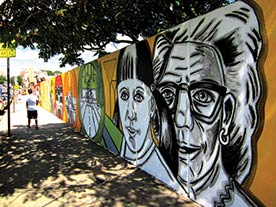What do community-based, affordable housing developers do?
We know they build houses: bricks and mortar, glass and steel, places where people live. But that’s not all, is it?
Since their early years, community-based organizations have been about change. The goal has been to reverse the decay and disinvestment of our poor inner-city and rural communities. While neighborhood destruction was most readily seen in crumbling housing, it was equally significant in the lack of jobs, poor schools, lousy city services, and dangerous streets. Every part of the community needed rebuilding.
Such broad-based change was, and remains, a big job. Most organizations broke it down into parts and tackled perhaps the most important piece first; the one mostly likely to lead to rebuilt communities – creating homes.
After all, “[h]ome is where our connection to our community, our city, and our country begins,” says a recent HUD publication. “There is no better foundation for rebuilding communities and restoring self-sufficiency…”
Doing More
So while CDCs and other community-based housing organizations have been laying the foundations for new homes, they’ve also been rebuilding the “social fabric.” They’ve been strengthening families, building neighborhood associations and networks, empowering residents to take charge of their neighborhoods by teaching them how to organize, interact with government, and manage their buildings. This work beyond building homes is often done without fanfare or even acknowledgment.
Alice Shabecoff and Paul Brophy think it’s time for CDCs to speak up and be clear about the role they’ve undertaken. “The irony,” say Shabecoff and Brophy, “is that over the years, as CBDOs downplayed their explicit social mission and emphasized their technical capacity to do hard deals, a field of research has asserted that it is a strong social fabric that brings about economic health, rather than vice versa. Hard and soft are irrelevant distinctions when both are needed to bring about change.”
All the recent chatter about community building and the need for comprehensive solutions has finally given CDCs the chance to be clear about all they do that goes beyond physical redevelopment. As Shabecoff and Brophy say, “…the growing recognition of the importance of “social fabric” gives us an opportunity to frame a vocabulary that articulates the social mission as part of the community-based development strategy and to find practices that are consistent with what CBDOs are already doing.”
But, finding the words and identifying those practices won’t come cheaply, and, unfortunately, “No one is funding social cohesion. …Funders have only recently funded social service initiatives as part of their ‘holistic’ community development concept. They certainly aren’t funding organizing or activities they would say are ‘soft.'”
So here’s the dilemma. CBDOs do much more than build houses, but what that is, exactly, is very hard to define, even harder to measure, and rarely paid for. Yet, without strengthening community, physical redevelopment won’t lead to permanent change.
Doing Less
And that’s not all. Some people say that most CDCs can barely build houses, much less build community. Some, such as Randy Stoecker, say that CDCs dance to the tune of bankers, foundations, and government programs and cannot be responsive to the community. CDCs are so poorly funded and staffed, Stoecker adds, that they rarely have the professionalism and capacity to make any significant physical impact on their communities. “It is too much to expect a CDC to be resistant enough to ward off market pressures attempting to co-opt its agenda, accountable enough to remain under community control, yet large enough to do the job that’s needed in disinvested communities,” writes Stoecker.
Stoecker suggests that there should be larger, but fewer CDCs that serve numerous communities, under the direction of resident-based planning and organizing groups within those communities. Peter Levavi offers us the examples of two large Chicago-based CDCs who’ve taken their expertise on the road, providing a range of services to smaller CDCs incapable of or uninterested in developing certain skills among their staffs. Is this the wave of the future, as funding “devolves” to our communities (and grows scarcer) and collaboration becomes more common?
What You Do
This brings us back to the question of what community-based development organizations do. What do you do? Do you build houses or create homes? Do you provide social services or do you repair the social fabric? We look forward to your feedback on the articles in this issue, and hope we can gather your experiences to add to the growing body of housing and community development wisdom.




Comments